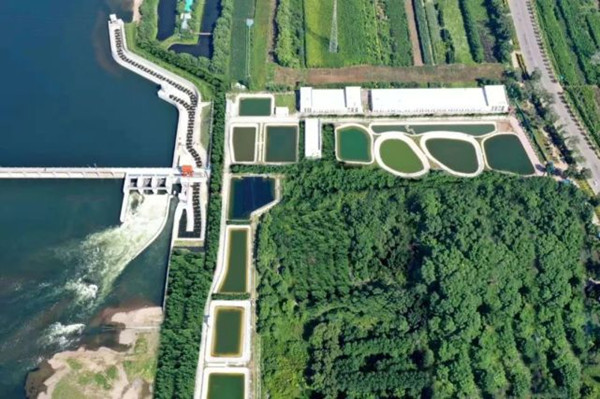
A bird's-eye view of the "fish ladder" at the Fengman hydropower Station in Songhua River in Jilin, Northeast China's Jilin province. [Photo provided to chinadaily.com.cn]
The survival chances of fish migrating upstream in Jilin province's Songhua River Basin have been vastly improved through human ingenuity and an innovative system that helps them circumvent large dams.
Driven by an instinct to spawn in the river's upper reaches from late spring to summer, they encounter two 100-meter-high dams at Fengman hydropower station.
Fortunately, the staff of the hydropower station has devised a clever way for the fish to complete their upstream journey-the first time the migration has been successful in 80 years.
When they come to the lower dam, the fish are enticed to swim into a man-made current that guides them into a large bucket. The bucket is then lifted out of the water and loaded onto a carriage running on tracks to a staging location, where it is hoisted to the top of the dam by a port crane.
A crane then places the bucket on a ship, which carries it to predetermined release points on the lake. Workers open the bucket, and the fish swim to freedom, helping ensure the survival of a number of species. From start to finish, the automated transportation of the fish-which include lamprey, burbot, grass carp, black carp and chub-covers 30 kilometers and the entire process is done by remote control.
"The migration season for fish in the Songhua River is from May to August. However, the channel has been blocked for more than 80 years, since the old dam was built in 1937," said Liu Yalian, chairwoman of the labor union of the Fengman construction bureau of State Grid Xinyuan, which runs the station. Installed capacity of the station reaches 1.48 million kilowatts of electricity, mainly offering power for Northeast China.
Interruption of fish migration may separate a species upstream and downstream, reducing genetic diversity. It may also change the habitats of some fish, affecting their growth and reproduction and threatening the environment, experts said.
The company began building the innovative fish transport system in 2018, in line with the national strategy to emphasize ecological preservation during development projects, Liu said.
The system-an elaborate fish ladder-began trial operations in July. It has enabled fish migration to resume, allowing some 50,000 fish to pass in July and August, including some rare and endangered species.
Du Xiaoyan, director of the science and education department at the Jilin Academy of Aquatic Science, said the fish ladder will ease the negative influence of dams on migration, and play an important role in promoting a diverse gene pool. It will support the breeding, growing and overwintering of fish, helping safeguard a balanced ecosystem in the Songhua River Basin, as well as sustainable development.
Safety first
It takes four to seven hours to transport one bucket of fish. Oxygen is injected into the water, and the condition of the fish is monitored. Photos of the fish are taken by underwater cameras to tally numbers and identify species. These are uploaded to computers in real time.
The system was designed to avoid people touching or netting the fish, which can harm their chances of survival. "No fish has been found dead when the release gate is opened," Liu added.
Because it is automated, the system requires only two maintenance workers and four workers on the ship to complete the assisted migration. Operating costs are thus minimized and efficiency is enhanced.
"We didn't expect the system to function so well from the start, but seeing the massive number of fish of different shapes and colors jump into water, we felt happy," Liu said. "We even saw hundreds of ospreys gather there."
Challenges include stabilizing water currents at fish collection points. Water flows around a station can change drastically in the electrical regulation process, especially during peak output, said Zhou Binghao, senior engineer of the program from China Water Northeastern Investigation, Design and Research.
Precise monitoring of water levels is needed to judge when to open and close the sluices, he said. Equipment must be kept in top condition to make the system work, so unfixed items are stored in a warehouse during the winter.
"The success of this program will serve as an example for other large hydropower stations," Zhou said, adding that in the future, efforts will be made to optimize the system to attract more fish and reduce transport time.
"The emphasis on ecology shows that awareness of environmental protection is rising as national economic strength grows," he said.
Li Xintong, 21, who lives in Fengman district, Jilin, said: "I heard about the fish ladder and I think it's a great thing. There are more fish in the Songhua River with different variety. The surrounding environment also became better. I'm glad to see our ecological environment improving."







